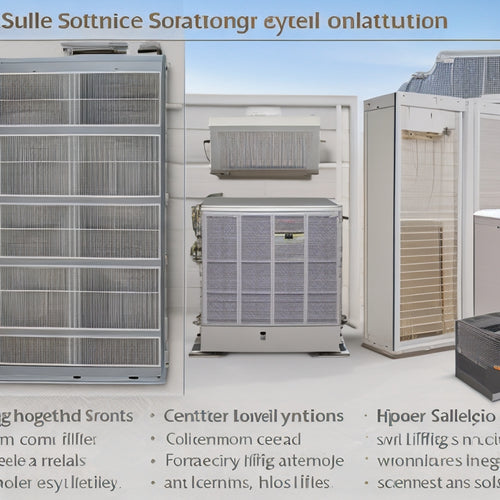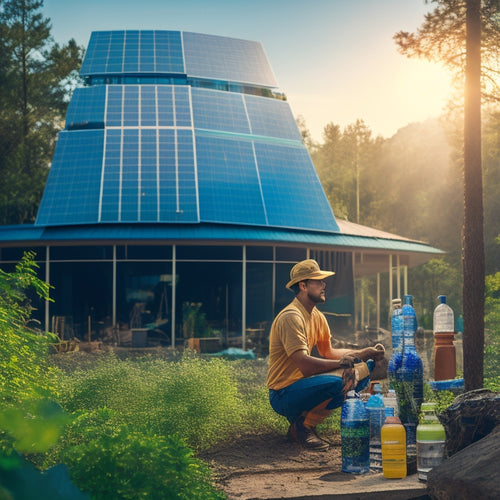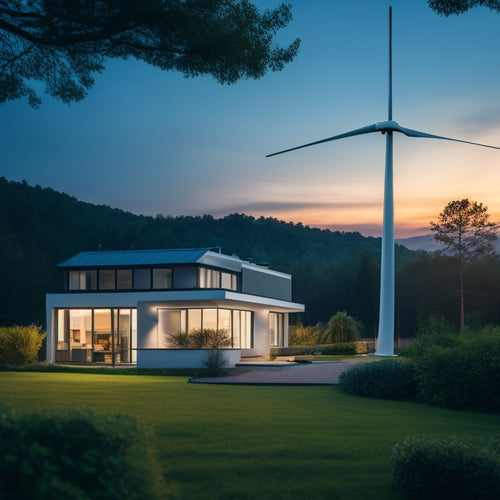
7 Smart Cooling Hacks for Energy-Savvy Home Offices
Share
You can slash your energy bills and create a comfortable working space in your home office by leveraging smart cooling hacks. Enhance air circulation naturally by opening windows, using thermal mass materials, and maintaining humidity control. Shade matters too - invest in thermal curtains, outdoor shades, and apply light colors to reduce heat absorption. Investigate evaporative cooling techniques, reverse your ceiling fan direction, and choose cool colors for walls that reflect sunlight and heat. By implementing these strategies, you can reduce your reliance on air conditioning and create a more comfortable workspace - and there's even more to uncover to optimize your home office cooling.
Key Takeaways
- Boost air circulation naturally by opening windows, utilizing thermal mass materials, and strategically placing desks and plants.
- Use thermal curtains, energy-efficient blinds, and outdoor shades to block UV rays and reduce heat gain.
- Leverage evaporative cooling techniques, such as cooling towers and whole-house systems, to cool air efficiently.
- Reverse ceiling fan direction to recirculate cooler air and reduce reliance on air conditioning.
- Utilize cool colors on walls, such as light blue and soft green, to reflect sunlight and heat, enhancing energy efficiency.
Boost Air Circulation Naturally
You can considerably reduce the temperature in your home office by utilizing natural air circulation. Open windows on opposite sides of your office to create cross ventilation, allowing natural breezes to flow in and out. This airflow pattern helps remove heat and humidity, improving air quality.
By incorporating sustainable practices, such as Renewable Energy Sources for powering your office, you can further minimize your carbon footprint. Thermal mass materials, such as concrete or brick, can absorb heat during the day and release it at night, further aiding passive cooling.
By strategically placing windows, you can utilize natural ventilation to reduce the need for mechanical cooling systems. Proper humidity control is also essential, as high humidity can make your office feel warmer than it actually is.
Shade Matters for Cooling
As natural ventilation does its part in keeping your home office cool, another key factor to contemplate is the strategic use of shade. By controlling the amount of direct sunlight entering your space, you can greatly reduce the heat gain.
High-efficiency solar panels can also be used to power energy-intensive cooling systems, ensuring a reliable and sustainable energy supply high-efficiency solar panels.
-
Invest in window treatments like thermal curtains or energy-efficient blinds that block UV rays and keep the heat out.
-
Consider outdoor shades or solar screens that can filter the sun's rays before they reach your windows.
-
Use light colors and reflective surfaces on walls and furniture to bounce sunlight away from your workspace.
Evaporative Cooling Magic
You're likely familiar with the concept of evaporative cooling, but did you know you can utilize its magic in your home office?
To get started, it's crucial to understand the basics of cooling towers and the different types of evaporative cooling systems available.
In fact, leveraging solar-powered charging solutions can also reduce your carbon footprint and energy costs.
Cooling Tower Basics
How does evaporative cooling magic happen in a cooling tower? It's simple: hot air is drawn into the tower and passes through a wet pad, which cools it down through evaporation. This cooled air is then blown into your home office, providing a rejuvenating atmosphere.
As we shift to sustainable electrification, incorporating renewable energy sources like solar power can greatly reduce our carbon footprint. Effective energy storage solutions, such as batteries, guarantee a stable power supply despite the intermittent nature of solar power.
To guarantee your cooling tower runs efficiently, keep these tips in mind:
- Regularly clean the wet pad to prevent clogging and maintain cooling tower efficiency.
- Perform routine cooling tower maintenance to prevent scaling and corrosion.
- Confirm proper airflow by keeping the tower's surroundings clear of debris.
- Monitor the tower's water level to prevent dry running, which can lead to overheating.
Evaporative Cooling Types
Evaporative cooling magic comes in various forms, each with its unique advantages and applications. You can choose the one that best suits your home office needs.
| Type | Benefits | Suitable For |
|---|---|---|
| Portable Evaporative Coolers | Easy to move, low maintenance | Small to medium-sized rooms |
| Swamp Coolers | Energy-efficient, low cost | Dry climates, outdoor spaces |
| Whole House Evaporative Cooling Systems | Cools entire house, improves air quality | Large homes, areas with low humidity |
| Evaporative Cooling Fans | Cost-effective, easy installation | Small rooms, personal spaces |
These evaporative cooling types offer swamp cooler benefits, such as energy efficiency and low costs. By understanding the features and applications of each type, you can make an informed decision to create a comfortable and productive home office environment.
Improving Air Flow
Most home offices can benefit from a strategic air flow setup, which is essential for effective evaporative cooling. You can optimize airflow patterns by analyzing your office's layout and identifying areas where air tends to stagnate.
By incorporating ventilation techniques, you can create a more efficient cooling system that reduces energy consumption. Implementing sustainable practices, such as transitioning to green vehicles, can also lead to a more eco-friendly work environment.
Additionally, monitoring emissions and performance can help you identify areas for improvement in your energy consumption.
- Position your desk near a window to take advantage of natural ventilation
- Install vents or whole-house fans to circulate air throughout your office
- Use floor fans to redirect airflow and speed up evaporation
- Strategically place plants to enhance air circulation and purify the air
Ceiling Fans on Reverse
One often overlooked trick for keeping your home office cool is to run your ceiling fans in reverse.
This simple hack can provide significant ceiling fan benefits, especially during warmer months. By reversing the fan's direction, you can recirculate the cooler air near the floor, reducing the need for air conditioning and creating energy efficient settings.
This technique is particularly effective in rooms with high ceilings, as it helps to redistribute the cooler air that's often trapped near the floor.
By doing so, you can enjoy a cooler workspace while minimizing your energy consumption.
Cool Colors for Walls
You can create a cooler home office by selecting wall colors that not only calm your mind but also reduce heat.
Calming color schemes, such as light blues and pale greens, can help you stay focused and composed.
Additionally, heat-reducing hues like whites and creams can reflect sunlight and heat, keeping your space cooler and more comfortable.
Calming Color Schemes
Alter your home office into a serene retreat by incorporating calming color schemes on your walls. This isn't just about aesthetics; color psychology plays a significant role in influencing your mood and productivity.
Soothing palettes can help you stay focused and relaxed, even on the most demanding days.
-
Soft blues, like sky blue or light cerulean, promote feelings of tranquility and trust.
-
Pastel greens, such as mint or sage, can reduce stress and improve concentration.
-
Creamy whites and beiges create a sense of calmness and clarity.
- Gentle lavenders can help you unwind and relax, perfect for a home office.
Heat-Reducing Hues
As calming color schemes set the tone for a serene home office, it's equally important to contemplate the thermal impact of your wall colors. You see, certain hues can actually increase the temperature in your space, making your cooling system work harder and driving up energy costs. This is where color psychology comes into play. By choosing heat-reducing hues, you can create a cooler and more energy-efficient environment.
| Color | Temperature Impact | Energy Efficiency |
|---|---|---|
| Light Blue | Cooling | High |
| Soft Green | Neutral | Medium |
| Warm Beige | Warming | Low |
| Dark Brown | Warming | Very Low |
Opt for light blue or soft green walls to keep your home office cool and energy-efficient. These colors not only promote a sense of calm but also reflect sunlight and heat, reducing the need for air conditioning.
Nighttime Cooling Strategy
During the cooler nighttime hours, your home office's thermal mass - including furniture, walls, and flooring - has a unique opportunity to release stored heat, setting the stage for a more efficient cooling strategy.
By taking advantage of nighttime ventilation, you can flush out the heat that's built up during the day, allowing your space to cool down naturally. This means you'll use less energy to cool your home office the next day.
Here's how to make the most of nighttime cooling:
- Open windows and doors to let cool air in and hot air out
- Use cross-ventilation to create a cooling breeze
- Switch to cooler bedding to keep yourself comfortable while sleeping
- Consider running a whole-house fan or ceiling fan to circulate air and speed up cooling
Plant-Based Cooling Solutions
You've successfully cooled your home office overnight, now it's time to bring in some natural allies to help keep the space cool during the day.
Indoor plants are a great addition to your cooling strategy, as they're capable of regulating natural humidity levels. This process, known as transpiration, occurs when plants release moisture into the air through their leaves, which can lower the temperature by up to 9°F.
Strategically placing plants in your home office can create a microclimate that reduces the need for air conditioning. Choose plants like peace lilies, spider plants, or snake plants, which are known for their air-purifying properties and ability to thrive in indoor conditions.
Frequently Asked Questions
Can I Use Fans in Conjunction With Air Conditioning for Better Cooling?
As you're sweating bullets, you wonder: can fans and AC unite for ultimate cooling? Yes, you can! Strategically place fans to enhance air circulation, creating a cooling breeze that lets you dial down the AC, saving energy and sweet freedom.
How Often Should I Clean My Ceiling Fan to Maintain Efficiency?
You should clean your ceiling fan every 2-3 months to maintain effectiveness, as dust buildup reduces airflow and increases energy consumption; regular ceiling fan maintenance guarantees ideal cleaning frequency for a cooler, freer you.
Are There Specific Plants That Are More Effective at Cooling Than Others?
As you step into a lush oasis, reminiscent of a serene forest, you'll find that certain air-purifying plants like peace lilies and spider plants excel at humidity control, naturally cooling the air around you, while others, like aloe vera, provide an added bonus of soothing skin irritations.
Can Smart Thermostats Help With Energy Efficiency in Home Offices?
You can optimize energy efficiency in your home office by using smart thermostats that offer smart scheduling and temperature zones, allowing you to customize your cooling needs and automate energy-saving settings when you're not working.
Are There Any Energy-Efficient Cooling Solutions for Basement Home Offices?
You're probably wondering if your basement home office can stay cool without breaking the bank. Yes, you can achieve energy efficiency by ensuring proper basement insulation and humidity control, which helps reduce cooling needs and saves you money.
Related Posts
-

Why Solar HVAC Filters Revolutionize Home Energy Efficiency
By adopting solar HVAC filters, you're shifting your home's energy reliance from fossil fuels to clean, renewable sou...
-

What Tax Deductions Apply to Sustainable Building Materials?
You can claim various tax deductions for sustainable building materials, thanks to over 40 federal tax incentives sup...
-

10 Grid-Tied Wind Power Systems for Modern Homes
You're looking for a grid-tied wind power system to utilize wind energy for your modern home. Here are ten options to...


